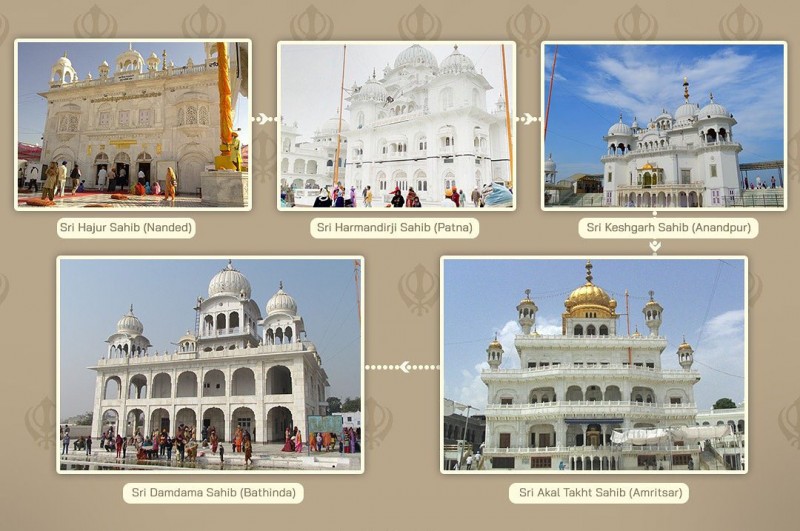
Takht which means throne or seat of authority is a result of the historical growth of Sikhism. There are five Takhts. Two of the Takhta are located outside Punjab and all the other three are within the Punjab.
Guru Hargobind founded the first and most significant one in 1609. It is located directly across from the gate of Harmandir Sahib - The Golden Temple, Amritsar, and is known as "Akal Takht" (the Throne of the Timeless God). The Guru created it because he believed that the Golden Temple, which is intended solely for the worship of God, should not be used to discuss secular political issues. The Guru conducted his court here and made decisions regarding political and military strategy. Later, decisions about matters of peace and war and the resolution of disputes between various Sikh groups were made here by the Sikh Commonwealth (Sarbat Khalsa).
At this location, the Sarangi singers sang the ballads of the Sikh Gurus and warriors, and robes of honor (sarcomas) were given to individuals who performed noteworthy contributions to the community of men as a whole. The name "Takht Sri Patna Sahib" is given to the second seat of power. The five Gurudwara collectively known as "The Five Takhts" hold a particularly unique place in the hearts of Sikhs. The word Takht means throne. They are regarded as the centers of Sikh religious power. Here, significant decisions affecting the Sikh community's social and religious life have been made.
Also Read Khalsa Panth: Community and Faith of Sikhism
Sri Akal Takht Sahib
Translated as Eternal Throne is Akal Takht Sahib. It is a component of the Amritsar Golden Temple complex as well. Guru Hargobind Sahib laid the building's foundation. A corridor connects the Akal Takht and Harmandir Sahib, which are located next to each other. Akal Takht, the structure next to the Golden Temple, has a special significance. The Akal Takht represents the administration of justice and temporal activities, whilst the Golden Temple represents spiritual instruction. The Guru Granth Sahib is kept in the Golden Temple during the day and the Akal Takht Sahib at night. Before entering the battlefields in the past, all Sikh warriors came here to ask for blessings.
Sikhs used to congregate at the Akal Takht on major occasions like Baisakhi and Diwali when they were engaged in a guerilla battle in the forests during the 18th century. The locals used to gather for general meetings and vote on resolutions. Of the Five Takhts, the Akal Takht is the oldest.
Takht Sri Damdana Sahib
Damdama Sahib that Guru Gobind Singh Ji prepared the revised and authentic version of the Adi Granth into the final edition of Sri Guru Granth Sahib which is now honored by the Sikh's eternal Guru or spiritual guide to all Sikhs.
Sri Guru Gobind Singh Ji spent around a year at Damdama sahib where he added poems from Guru Tegh Bahadur to the original Sikh scriptures composed by Guru Arjan Sahib which includes the teaching of all the previous Sikh Gurus.
The Damdama Sahib Bir is another name for the final guru Gobind Singh Ji that was written at Damdama Sahib. Numerous new converts accepted Sikhi and joined the Khalsa during Guru Gobind Singh’s visit.
Damdama means a place to have a break and rest. Guru Gobind Singh Ji stayed there after the battle against Mughal atrocities.
Also ReadThree Pillar of Sikhi : Spiritual Elevation
Takht Sri Keshgarh Sahib
Takht Sri Keshghar Sahib is situated at Anandpur Sahib, Ropar, Punjab is one of the most holy places of the Sikhs. Anandpur Sahib means the City of Spiritual Bliss. Takht Sri Keshghar sahib is the birthplace of the Khalsa. The order of the Khalsa was founded here by Sri Guru Gobind Singh Ji in 1699.
The Guru Sahib called for a special congregation on the Vaisakhi day of 1699 with thousands of Sikhs in attendance. Takht Sri Keshghar Sahib stands at the place where Guru Gobind Singh Ji initiated the Panj Pyaras the five beloved ones and administered Amrit to them.
Takht Sri Hazur Sahib
Hazur sahib also known as Takht Sachkhand Sri Hazur Sahib is one of the five Takhts in Sikhism. Huzur Sahib is a title of reverence meaning ‘Exalted Presence’. Takht Sachkhand Sri Hazur is situated on the bank of the Godavari River in Maharashtra. This is the place where Sri Guru Gobind Singh re-joined with God and commanded Sikhs to follow the Guru Granth Sahib as the Guru. Sachkand means the region of truth was used as a word by Guru Nanak Dev Ji to mean the abode of God. Maharaja Ranjit Singh (1780–1839), who gave the order to construct the Gurudwara.
Takht Sri Patna Sahib
Takht Sri Patna Sahib also known as Harmandir Sahib is gurudwara located in Patna, Bihar. It was done in the memory of the Guru Gobind Singh Ji the tenth guru of the Sikhs who was born on December 1666. Guru Gobind Singh Ji was born in Patna. He spent his childhood in the Patna Sahib before moving to Anandpur Sahib. Besides the born of the tenth guru, the first guru Sri Guru Nanak Dev Ji visited Patna during Udasi the world journey, and the ninth guru Sri Tegh Bahadur Ji. The Gurudwara now commemorated Guru Gobind Singh Ji.
Also Read: Hazur Sahib : Gurudwara Nanded Sahib